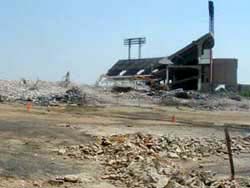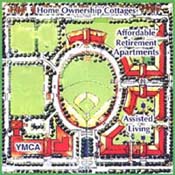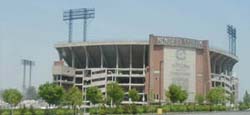| Maryland Newsline |
| Home Page |
Politics
|
| Final Score: Wrecking Ball
Razing Memorial Stadium
By
Kim Harris BALTIMORE - A wrecking ball is scheduled to reduce Memorial Stadium to rubble by September to make way for a retirement community. For activists who fought to preserve the stadium, this amounts to the loss of a beloved landmark. For the company redeveloping the site into Stadium Place, it’s an opportunity to bring affordable senior housing to Baltimore. Winning the Fight “They thought we were going to fail, but we didn’t, and we have a right, with the city, to develop that land,” says Julia Pierson, executive director of Govans Ecumenical Development Corp., a nonprofit, church-based development group building Stadium Place with Presbyterian Home Inc.
The new development will provide about 500 senior citizens with low-cost senior housing, health care and personal services. Housing options will include 30 cottages, 320 one- and two-bedroom apartments and an 80-unit assisted living center. A YMCA will also be built on the site and provide daily programs and services for seniors and the community. The Fight to Save a Landmark "We recognize that we were late in the game, for one,” says Tyler Gearhart, executive director of Preservation Maryland, ticking off reasons his group lost the legal battle to save the stadium. “But we thought that it would be a real tragedy to have it torn down.” The 50-year-old stadium had a rich past: It had been home to the Baltimore Orioles baseball team and the Colts and Ravens football teams. But by 1998, the Orioles had moved to Camden Yards and the Ravens had moved to PSINet Stadium, and Memorial Stadium stood unused. The city solicited redevelopment bids, and Stadium Place was among the three that came back. It was the only proposal that called for demolishing the stadium. Johns Hopkins also submitted a plan: to redevelop the stadium into a research park. Another reuse proposal came in from Struever Bros., Eccles and Rouse Inc. It called for using the site for housing, a supermarket, bank, ice skating rink and health center. The four neighborhood associations in the stadium community sided with Stadium Place, and Daniel Henson, then commissioner of the Baltimore City Housing Commission, signed off on the deal, a spokesman says. Former governor William Donald Schaefer, a member of the state Board of Public Works which was asked to allocate money for the stadium's demolition, tried to explain why the two reuse plans failed. “The first proposal [Johns Hopkins] was not well presented,” he said. He added that developers of the senior project "came in and said we would be able to start building right away. I think they [the community] were really impressed." Pierson said some area residents were against the Struever Bros. retail proposal because they feared it would compete with other shopping centers in the area. She said the community favored a residential solution for the site, and city officials based their decision on that. Schaefer said it's a shame, since that meant the stadium had to come down. "It is so easy to tear things down," he said. "It is so difficult to keep them up." The Fight Intensifies
Preservation Maryland spent three months lobbying the Maryland Board of Public Works to vote against releasing funds to demolish the stadium. But when the board met in January, it voted 2-to-1 to allocate the $5.85 million to the Maryland Stadium Authority. Schaefer, the state comptroller, cast the only dissenting vote. Preservation Maryland immediately appealed to the city’s Department of Housing and Community Development, but that appeal failed. The group also filed an unsuccessful request in Baltimore Circuit Court to stop the demolition. It tried one more legal tactic: It appealed to U.S. District Court in Baltimore, arguing the stadium was historic and should be saved. Unfortunately, Gearhart said, "the judge did not agree with us." Baltimore City Solicitor General Thurman Zollicoffer explained: "The judge said they did not have standing.... The judge [also] said that he was not sure if they would prevail on the merits of their case." Preservation Maryland did score one victory: It reached an agreement with the developer and Baltimore Mayor Martin O'Malley to save the 116-foot-tall facade facing 33rd Street, built in homage to World War II veterans. There is still a question as to which group will be in charge of the facade's upkeep. Because the stadium is owned by the city, it's "ultimately the city's responsibility," says Ed Cline, deputy director of the Maryland Stadium Authority. He was expected to meet with city officials to try to resolve the issue. A Deal Is a Deal Pierson says she understands Baltimore's attachment to the stadium. “I’m a Baltimorean. My heritage is with this stadium. I went to games as a kid.…. [But] we made a decision as a city, democratically, that we were going to take this stadium down. And we put our resources in new stadiums downtown. "So, although it is sad that a piece of our heritage is being torn down, it is a decision that we made," Pierson says. The developers have not yet signed any seniors for Stadium Place, but officials say they have about 400 people who have expressed interest. Norma Jean Moore, a GEDCO volunteer, is one of the 400. Moore says Stadium Place is "not just a place for old people, but sort of a new, provocative plan." The mix in housing options and the potential for diversity of people living and playing at Stadium Place was also a big attraction for her. The YMCA will offer programs for the young and old. It is expected to be completed spring or summer of 2003--about a year after Stadium Place opens. Copyright © 2001 University of Maryland College of Journalism. Text and limited photos available, with permission and credit, for use by Capital News Service clients.
|



